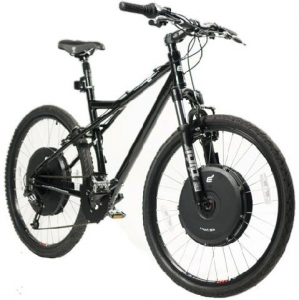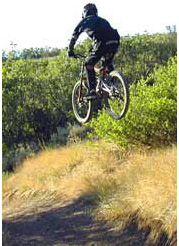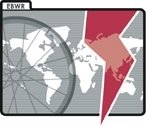Site Map FAQ Link Contact About
Electric Mountain Bike

Like any mountain bicycle, electric mountain bike need to be able to withstand the stresses of off-road riding with obstacles such as logs and rocks. In addition to that, we have to make sure that the electric components can withstand the rough conditions.
The motor and the battery both need to be protected from the road conditions, weather conditions and so on, also all the cable and cable connections are also neet to be sealed.
What type of terrain is suitable for an electric mountain bike?
Basically, we would like it to withstand anything a regular mountain bike can withstand and even more. Let's see why.
Gears
A geared motor is usually better when talking about hill climbing. Whether is crank drive or is chain drive.
The crank shaft motor have less friction, sealed better and generally offer better performance, it also uses the same gearing system as the rider which is good. They are not quite popular but I think it is going to change.
A big part of mountain cycling is the ability to choose the right gear for the right terrain. That's why they come with so many gears.
Think about riding a mountain bike with a single gear . It just doesn't make sense! Think about riding a car with a single gear. Who the hell would buy such a car? (Click here to read more about performance of different vehicles.)
For the same reason, putting a motor that have only one speed is not make any sense. It uses too much energy, it doesn't work at it's optimum point, it produce a lot of heat and it is far from being ideal.
Using such a bike in a urban, mostly flat area can be acceptable but think twice (and better, test ride) before buying such a system. It is also cheaper to use such a motor so there are certainly occasion when we choose it and not the other more expensive geared motor.
If despite all that, you are planning to use an electric system that does not incorporate the gear system, be sure to have enough power and torque!
Power
For anybody trying to go off-road with their electric mountain bike, I would recommend a motor 500w to 750w. Anything smaller than this won’t have the power to push you up steep hills.
Most of the electric bicycles today come powered with only 250 watts. This is the maximum allowed wattage in the European nation. In the the US, you can use a motor with up to 750W.
There are some places where the on-road laws are different from off-road laws so even if your country have forbidden using high wattage motor in urban places, you may still use it off road.
250W is badly underpowered when talking about biking in a very tough and hilly terrain. 250W is enough for urban commuting when the road is flat and without obstacles. It can also deal quite okay with small inclines.
But if you want a good electric mountain bike experience plan on using at least 500W of power and prefer even 750W or 1000W if you really want to feel the adventure.
Moreover, I can't emphasize enough the rule of the gearing system. If you use a motor which take advantage of the gearing, even 500W will do the job quite well, but if not, place a big enough motor.
Don't get me wrong, you will still have to pedal, but now you will experience you mountain riding from a different angle. You will experience it from an angle of a pro-rider and it is for sure a different experience.
If you are out of shape, the extra help will help you catch up with your other more fit friends.
Battery
Manufactures usually advertise an impressive mile range for there electric mountain bike. What they usually forget to tell you is that this range was achieved under lab conditions. Hence, flat road, no wind, no bumps and no obstacles.
So if a company advertise a 35 km range and you are going to use this bike for rough hill climbing, you will probably going to get half of this range.
Let's discuss again the importance of the gearing. The motor source of power is the battery, so if you are going to use a big motor, you are going to need a big battery. Otherwise, the range will too short and you will burn the battery more quickly in the long run.
On the other hand, if you use a geared motor, you will need a smaller motor and a conventional battery so it's a win win situation.
And this bring me straight to another important issue....
Brakes
Inexpensive mountain bikes usually come with V-brakes. It is okay to use such brakes when you are a beginner and you aren't going to encounter too rough and "tricky" off-road conditions.
But when you use an electric mountain bike with the recommended power, this is just another story. You must use disc brakes! You have the power now of a pro-cyclists and you ride fast so the V-brakes are far from satisfying.
Disk brakes offer improved stooping power over rim brakes under rough conditions and they should be your only choice. They are also built to last and require little to no maintenance.
Shock absorption
Rear and front shock absorption are pretty popular this days. They help solve the problem of speed reduction when the bicycle strikes an obstacles and they also make riding on rough terrain easier, less physically stressful for the rider and safer.
Using high quality performance seats can also help soften the jumps.
In the case of the electric mountain bike, shock absorption also help to reduce the stress conditions on the motor and the battery. It soften the forces and pressures.
The motor and the battery will thank you for this and they will live longer.
Moreover, if the motor is not sealed and protected, avoid of placing it too low. You don't want the motor to be hit by big rocks and logs. On the other hand, avoid from positioning the electric component too high because you usually want the center of gravity to be low enough for a better stability and sense of control.
Tires and wheels
Inexpensive mountain bikes usually come with inexpensive tires. Be sure you have tires that can withstand that high power and pressures caused by the high motor performance.
Don't assume that what you had in you previous mountain bike will be good enough in the case of electric mountain bike. This is true for the tires, as well as for the brakes and frame.
You want the frame to be strong, yet light. Don't compromise on the frame, you don't want it to bend or brake while you riding. Remember again, inexpensive bike are usually not designed for aggressive riding
Also, if you want to ride in rain, mud or snow conditions, the electric components (including the cables) have to be sealed and the tires have to be designed to this certain weather condition and terrain. More over, disk brakes operate better under rain.
And now for the wheels...
If the motor or the battery or both are places in the center of the wheel (rear or front), the wheel is going to be heavier. We've already discussed why this method of propulsion has some disadvantages when used for electric mountain bike and the extra wheel weight add another one.
The heavier the wheel, the more it moves away from the ground when hitting an obstacle. Then, the rider have to wait until the wheel will hit the ground to gain control again. Therefore, we would want the wheels to be as light as possible.
Pedelec or Twist & Go?
I've never drive on a pedelec mountain bicycle. It just make more sense to have them pedelec because the driving experience is maintained. Otherwise, because of the high wattage motor, they would feel too much like a motorcycle.
But then, I could be completely wrong (-:
Maintenance
In well designed electric mountain bike, no special maintenance is required other than what is needed in any non motorized mountain bike.
If the motor, battery, cables and all the other electric parts are sealed good enough, you won't have to worry about anything except taking good care of you battery like in an other e-bike
For summary, here is a video of one of the best electric mountain bikes in the market, enjoy.
And also a short nice article from Wikipedia about the relation between the Defense Advanced Research Projects Agency (DARPA) and electric mountain bikes: Montague Bikes
Return from Electric Mountain Bikes to Electric Bicycle Types and Styles
|









New! Comments
Have your say about what you just read! Leave me a comment in the box below.